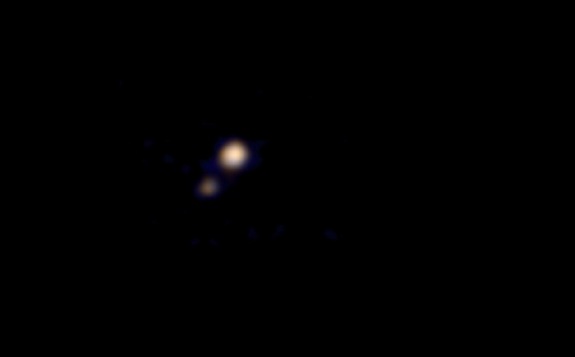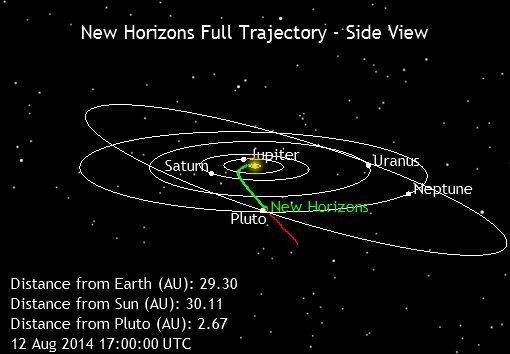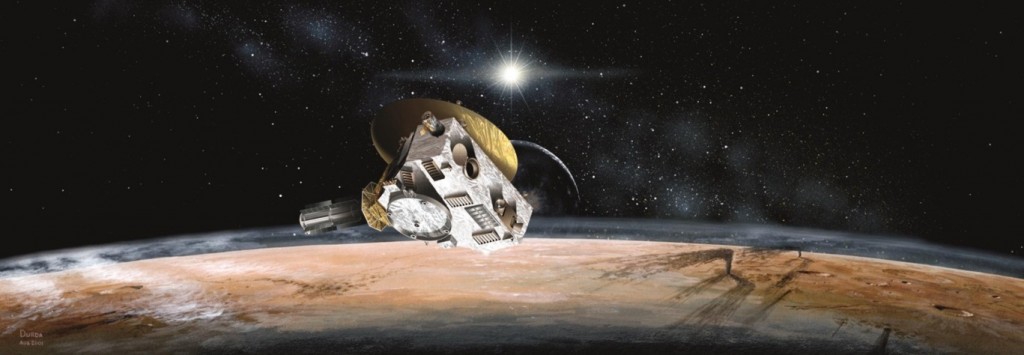Suicide Mission to Mercury Indicates Life on Earth Originated From Outer Space.
The US space exploration agency says its Spacecraft sent to study planet Mercury has achieved ‘unprecedented success’. The spacecraft, which is in effect on ‘a suicide mission’ has brought observations which prove Mercury harbors abundant frozen water and other volatile materials in its permanently shadowed polar craters.
Data indicates the ice in Mercury’s polar regions, if spread over an area the size of Washington, would be more than two miles thick. And for the first time, scientists have begun to see clearly a chapter in the story of how the inner planets, including Earth, acquired water and some of the chemical building blocks for life. A dark layer covering most of the water ice deposits on the planet Mercury supports the theory that organic compounds, as well as water, were delivered from the outer solar system to the inner planets and may have led to prebiotic chemical synthesis and, thus, life on Earth.

NASA’s New Horizons spacecraft returns its first color photos of Pluto (center) and its largest moon, Charon (lower left). Credit: NASA/Johns Hopkins University Applied Physics Laboratory/Southwest Research Institute
The future is now! NASA’s New Horizons mission to Pluto has returned its first color image of the dwarf planet and its largest moon, Charon. The new photo, was taken on April 9 from 115 million kilometres.
The mission is already revealing insights about Pluto and Charon, as well as suggestions of the science to come when New Horizons flies by the Pluto system on July 14, NASA officials said.
The image reveals “tantalizing glimpses of this system,” Jim Green, director of NASA’s Planetary Science Division, said during a news conference Tuesday (April 14), the day the photo was released. “You can immediately see a number of differences” between Pluto and Charon, Green added.
For example, Charon is dimmer than Pluto. The contrast may be due to a difference in composition of the two bodies, or it could even be caused by a previously unseen atmosphere on Charon, Green said. The uncertainty should clear up this summer, when New Horizons gets history’s first good look at the two ‘frigid’, faraway objects.
Pluto is getting its first close-up decades after planets such as Venus, Mars and Neptune received theirs. The delay means New Horizons is able to bring some pretty advanced scientific gear to the job.
NASA’s New Horizons spacecraft returns its first color photos of Pluto (center) and its largest moon, Charon (lower left). Credit: NASA/Johns Hopkins University Applied Physics Laboratory/Southwest Research Institute
New Horizons “is a real 21st century exploration spacecraft, with tremendous capability,” mission principal investigator Alan Stern, of the Southwest Research Institute in Colorado, said during Tuesday’s news conference. “It is in perfect health, full of fuel and carrying a scientific arsenal — the most powerful suite of science instruments ever brought to bear on the first reconnaissance of a planet.”
One of those is the Ralph color imager, which captured the new color photo of Pluto and Charon.
A new class of planets
In the early days of planetary exploration, there were two broad categories of planets — the rocky terrestrial planets from Mercury to Mars, and the enormous gas giants of Jupiter and beyond. Pluto was classified as a planet, but it was something of an oddball at the outer edges of the solar system.
Over the past few decades, it has become increasingly clear that Pluto is not so odd after all. In fact, it is just one of many similar objects in the Kuiper Belt, the ring of icy bodies beyond Neptune’s orbit.
“Fundamentally, we’re going to Pluto because it’s the human race’s first opportunity to study an entirely new class of world,” New Horizons co-investigator William McKinnon, of Washington University in St. Louis, said during the news conference.
The spacecraft reached Neptune’s orbit — nearly 2.75 billion miles from Earth — in a record eight years and eight months
When the New Horizons mission began taking shape, scientists knew about only one moon of Pluto — Charon, which is nearly 50 percent as wide as the dwarf planet. Since then, astronomers have used the Hubble Space Telescope to discover four additional — and much smaller — moons around Pluto.
There may be yet more moons waiting to be discovered, as well as a ring system or debris fields around Pluto. Such features could present a collision risk to New Horizons, but mission team members aren’t too concerned.
“As we did more testing of the spacecraft components back on Earth, our degree of concern declined with time,” Stern said. “The probability of something severe happening to New Horizons is very low —significantly less than 1 percent — around one in 10,000.”
That doesn’t mean the team is taking potential dangers lightly. They’ve worked out alternate paths for the spacecraft to take if it appears to be in danger. “We want to make sure we’ve taken every precaution to have a successful mission with New Horizons,” Stern said.
Flying into the unknown
New Horizons, which launched in January 2006, will be one of five spacecraft to visit the outer edges of the solar system, following in the footsteps of NASA’s Pioneer 10 and 11 and Voyager 1 and 2 probes.
New Horizons will be the only spacecraft to make a close approach to Pluto, traveling within 7,767 miles (12,500 km) of its surface. The dwarf planet takes 248 Earth years to make one trip around the sun. That means that one Pluto-year ago, Saturn was the most distant known planet; Neptune and Uranus had not been discovered yet.
Images and information sent back from the spacecraft will take about 4.5 hours to reach Earth, despite travelling at the speed of light. This means that many of the observations that will be made by New Horizons are scripted before it reaches Pluto. Furthermore, the spacecraft must choose between making new observations and sending its existing data to Earth; it can’t do both at the same time.
“It is one of the most automated planetary spacecraft ever launched,” Green said. For most of its trip, New Horizons remained in hibernation, waking up periodically to check that all systems remained functional and to occasionally study other planets as it passed them by. But in December, New Horizons received its last wakeup call, and began to collect information about the solar wind in the Kuiper Belt region approaching Pluto.
Discoveries about Pluto and its moons should begin long before the closest approach in July. Stern called the approach a six-month encounter that began in January. After flying by the system, New Horizons will turn around and attempt to study the dark side of Pluto by the light of its largest moon.
The $700 million New Horizons mission offers an opportunity to study Pluto and its five moons in detail, capturing data about the dwarf planet’s atmosphere, composition, interior, and formation. New Horizons will provide the first detailed look at a previously unexplored body in the solar system. “We’re flying into the unknown,” Green said. Source: Space.Com.
Scientists are currently debating on which of two optionst to study after the Pluto encounter, because the spacecraft New Horizons will still be having fuel after the July fly-by at Pluto. Follow the discussion on where else the spacecraft might be going to study one more object in space–much, much further away from the sun and earth; follow the discussion at this link.
‘Suicide Mission’ to Mercury
In a separate planetary exploration activity, the US space exploration agency says its Spacecraft sent to study the planet Mercury has achieved ‘unprecedented success’.
The spacecraft, which is in effect on ‘a suicide mission’ to mercury has brought observations which prove that the planet Mercury harbors abundant frozen water and other volatile materials in its permanently shadowed polar craters. [Of course most of the deep space exploration crafts are on suicide missions because they’ll never come back alive].
Data has indicated the ice in Mercury’s polar regions, if spread over an area the size of Washington, would be more than two miles thick.
And for the first time, scientists have begun to see clearly a chapter in the story of how the inner planets, including Earth, acquired water and some of the chemical building blocks for life.
A dark layer covering most of the water ice deposits on the Planet Mercury supports the theory that organic compounds, as well as water, were delivered from the outer solar system to the inner planets and may have led to prebiotic chemical synthesis and, thus, life on Earth.
The spacecraft sent to study is scheduled to self-destruct after many years studying the planet from the planet’s orbit, NASA has said in a press release. It will end its mission by a suicide impact onto the plane Mercury this month of April, 2015.
After extraordinary science findings and technological innovations, the NASA spacecraft launched in 2004 to study Mercury will impact the planet’s surface, most likely on April 30, after it runs out of fuel (propellant).
NASA’s MErcury Surface, Space ENvironment, GEochemistry, and Ranging (MESSENGER) spacecraft will impact the planet at more than 8,750 miles per hour (3.91 kilometers per second) on the side of the planet facing away from Earth. Due to the expected location, engineers will be unable to view in real time the exact location of impact.
Earlier this month, mission operators in mission control at the Johns Hopkins University Applied Physics Laboratory (APL) in Laurel, Maryland, completed the fourth in a series of orbit correction manoeuvres designed to delay the spacecraft’s impact into the surface of Mercury. The last manoeuvre is scheduled for Friday, April 24.
“Following this last manoeuvre, we will finally declare the spacecraft out of propellant, as this manoeuvre will deplete nearly all of our remaining helium gas,” said Daniel O’Shaughnessy, mission systems engineer at APL. “At that point, the spacecraft will no longer be capable of fighting the downward push of the sun’s gravity.”
Although Mercury is one of Earth’s nearest planetary neighbors, little was known about the planet prior to the MESSENGER mission.
“For the first time in history we now have real knowledge about the planet Mercury that shows it to be a fascinating world as part of our diverse solar system,” said John Grunsfeld, associate administrator for the Science Mission Directorate at NASA Headquarters in Washington. “While spacecraft operations will end, we are celebrating MESSENGER as more than a successful mission. It’s the beginning of a longer journey to analyze the data that reveals all the scientific mysteries of Mercury.”
The spacecraft traveled more than six and a half years before it was inserted into orbit around Mercury on March 18, 2011. The prime mission was to orbit the planet and collect data for one Earth year. The spacecraft’s healthy instruments, remaining fuel, and new questions raised by early findings resulted in two approved operations extensions, allowing the mission to continue for almost four years and resulting in more scientific firsts.
One key science finding in 2012 provided compelling support for the hypothesis that Mercury harbors abundant frozen water and other volatile materials in its permanently shadowed polar craters.
“The water now stored in ice deposits in the permanently shadowed floors of impact craters at Mercury’s poles most likely was delivered to the innermost planet by the impacts of comets and volatile-rich asteroids,” said Sean Solomon, the mission’s principal investigator, and director of Columbia University’s Lamont-Doherty Earth Observatory in Palisades, New York. “Those same impacts also likely delivered the dark organic material.”
In addition to science discoveries, the mission provided many technological firsts, including the development of a vital heat-resistant and highly reflective ceramic cloth sunshade that isolated the spacecraft’s instruments and electronics from direct solar radiation – vital to mission success given Mercury’s proximity to the sun. The technology will help inform future designs for planetary missions within our solar system.
“The front side of the sunshade routinely experienced temperatures in excess of 300° Celsius (570° Fahrenheit), whereas the majority of components in its shadow routinely operated near room temperature (20°C or 68°F),” said Helene Winters, mission project manager at APL. “This technology to protect the spacecraft’s instruments was a key to mission success during its prime and extended operations.”
The spacecraft was designed and built by APL. The lab manages and operates the mission for NASA’s Science Mission Directorate. The mission is part of NASA’s Discovery Program, managed for the directorate by the agency’s Marshall Space Flight Center in Huntsville, Alabama. For a complete listing of science findings and technological achievements of the mission visit: http://www.nasa.gov/messenger






